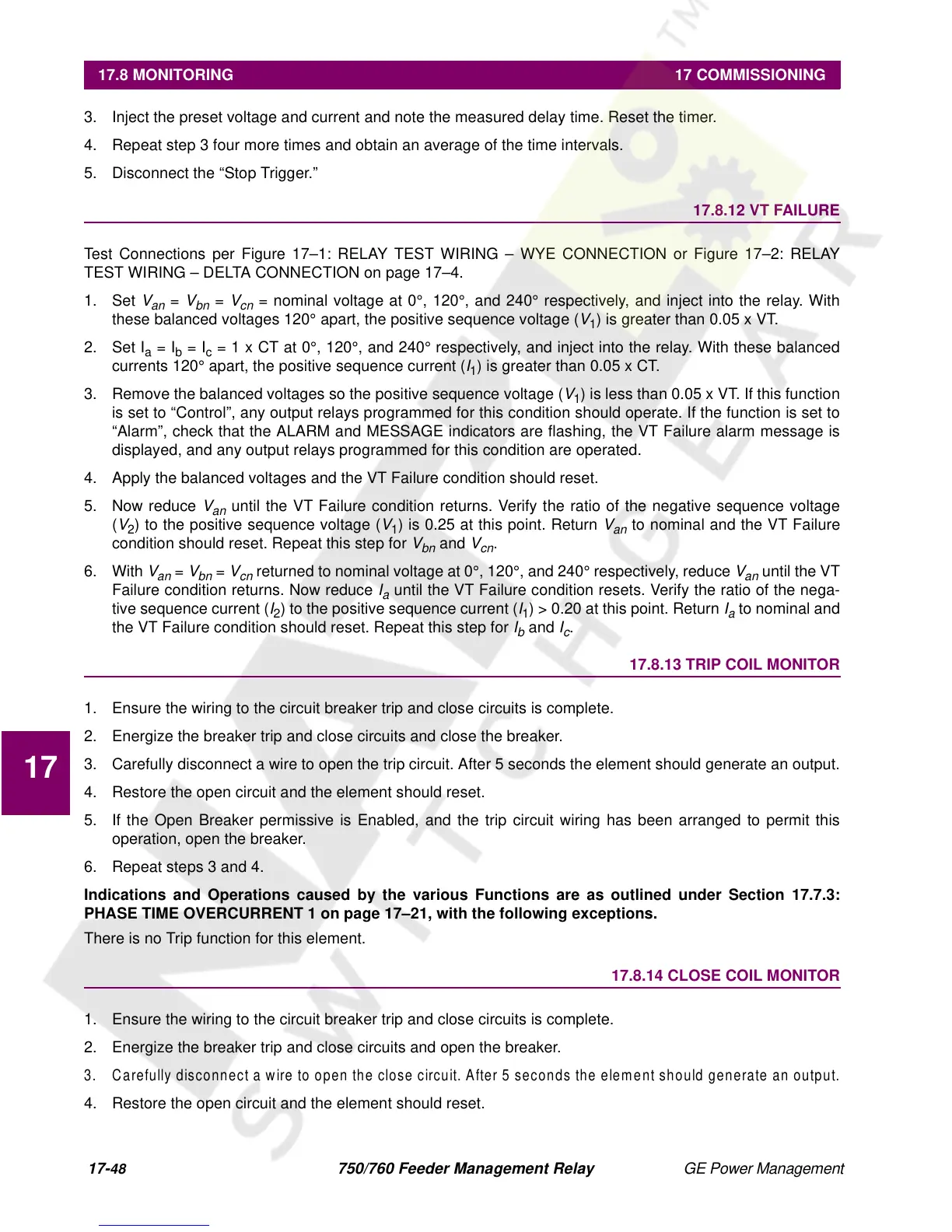17-
48
750/760 Feeder Management Relay GE Power Management
17.8 MONITORING 17 COMMISSIONING
17
3. Inject the preset voltage and current and note the measured delay time. Reset the timer.
4. Repeat step 3 four more times and obtain an average of the time intervals.
5. Disconnect the “Stop Trigger.”
17.8.12 VT FAILURE
Test Connections per Figure 17–1: RELAY TEST WIRING – WYE CONNECTION or Figure 17–2: RELAY
TEST WIRING – DELTA CONNECTION on page 17–4.
1. Set
V
an
=
V
bn
=
V
cn
= nominal voltage at 0
°
, 120
°
, and 240
°
respectively, and inject into the relay. With
these balanced voltages 120
°
apart, the positive sequence voltage (
V
1
) is greater than 0.05 x VT.
2. Set I
a
= I
b
= I
c
= 1 x CT at 0
°
, 120
°
, and 240
°
respectively, and inject into the relay. With these balanced
currents 120
°
apart, the positive sequence current (
I
1
) is greater than 0.05 x CT.
3. Remove the balanced voltages so the positive sequence voltage (
V
1
) is less than 0.05 x VT. If this function
is set to “Control”, any output relays programmed for this condition should operate. If the function is set to
“Alarm”, check that the ALARM and MESSAGE indicators are flashing, the VT Failure alarm message is
displayed, and any output relays programmed for this condition are operated.
4. Apply the balanced voltages and the VT Failure condition should reset.
5. Now reduce
V
an
until the VT Failure condition returns. Verify the ratio of the negative sequence voltage
(
V
2
) to the positive sequence voltage (
V
1
) is 0.25 at this point. Return
V
an
to nominal and the VT Failure
condition should reset. Repeat this step for
V
bn
and
V
cn
.
6. With
V
an
=
V
bn
=
V
cn
returned to nominal voltage at 0
°
, 120
°
, and 240
°
respectively, reduce
V
an
until the VT
Failure condition returns. Now reduce
I
a
until the VT Failure condition resets. Verify the ratio of the nega-
tive sequence current (
I
2
) to the positive sequence current (
I
1
) > 0.20 at this point. Return
I
a
to nominal and
the VT Failure condition should reset. Repeat this step for
I
b
and
I
c
.
17.8.13 TRIP COIL MONITOR
1. Ensure the wiring to the circuit breaker trip and close circuits is complete.
2. Energize the breaker trip and close circuits and close the breaker.
3. Carefully disconnect a wire to open the trip circuit. After 5 seconds the element should generate an output.
4. Restore the open circuit and the element should reset.
5. If the Open Breaker permissive is Enabled, and the trip circuit wiring has been arranged to permit this
operation, open the breaker.
6. Repeat steps 3 and 4.
Indications and Operations caused by the various Functions are as outlined under Section 17.7.3:
PHASE TIME OVERCURRENT 1 on page 17–21, with the following exceptions.
There is no Trip function for this element.
17.8.14 CLOSE COIL MONITOR
1. Ensure the wiring to the circuit breaker trip and close circuits is complete.
2. Energize the breaker trip and close circuits and open the breaker.
3. Carefully disconnect a wire to open the close circuit. After 5 seconds the element should generate an output.
4. Restore the open circuit and the element should reset.
